Early Season Treats from the Garden and the Woods
Posted on Tuesday, May 9, 2023 · Leave a Comment
Even if you planted your peas and spinach in April, you will not be eating them anytime soon. Despite days of full sun and occasional days of high temperatures, spring in New England is often cold and rainy, too. Our vegetable gardens putter along, but few things are ready to eat until June – or later. But there are vegetables you can be eating now, however, if you plan right.

Parsnips will grow in soil suitable for carrots and are an early spring treat
I eat parsnips as soon as the snow melts and the ground thaws. How? I overwinter parsnips in the ground, which sweetens them up and makes them even tastier. I plant parsnip seeds in June – they need warm soils to germinate. Even then, they take 2 to 3 weeks to come up out of the ground.
Parsnip seeds only are good for one year, so buy new seeds each year. Plant the seeds an inch apart and half an inch deep. A key to success is to thin your parsnips so they are not crowded. Thin them in July when the greens are 4- to 6-inches tall They need 3 to 4 inches of space between plants if you want good-sized parsnips. If you mulch the plants well with ground-up autumn leaves or straw, your work is done until harvest time the following spring.
Parsnips are an old fashioned vegetable, but prepared properly they are delicious. I peel and chop parsnips into half-inch thick slices, and steam them until slightly soft. Then I cook them briefly in a frying pan with butter. At the last moment I add maple syrup and cook at low heat until it caramelizes. Yum! Don’t have any this year? You can buy parsnips at your farmers market or even the grocery store.

Sorrel is ready to eat now for me
A little-known perennial green is sorrel. Once established, it produces a plethora of light green, lemon-flavored leaves, year after year. The French make soup with it, perhaps because the greens themselves pretty much melt and disappear if you sauté them. So for years I just added them raw to salads.
Then I got Deborah Madison’s wonderful cook book, “Vegetable Literacy”. She uses sorrel with peas and leeks to make a soup. But I don’t really follow recipes, and found that yes, indeed, sorrel goes well with peas. But I found I can boil frozen peas, then at the last minute add chopped sorrel. Just boil it for another minute, drain, add butter and enjoy!
Another early perennial vegetable, asparagus, is also coming in to season. If you like asparagus – and I can’t imagine anyone not liking it steamed and slathered in butter – you should grow it. It is mostly sold as crowns (roots), not seeds, for starting a patch, but seeds are available if you want to start an acre of asparagus.
Don’t crowd your asparagus. The roots are sold in bundles of 25, which is fine for a family of two. Plant them 18 inches apart and six inches deep. Buy any of the Jersey hybrids, they are all male and won’t start new plants that will crowd out your established plants. When planting, add lots of compost and some organic fertilizer. They like full sun, and plenty of moisture, but will grow with as little as 4- to 6- hours of sunshine if that is all you can offer.
To keep on getting good asparagus every year, keep it well weeded and top dress it with organic fertilizer every year after you finish picking. Mulch is good for keeping weeds down. And don’t over-pick your asparagus: three weeks is the season for a well-established patch. Don’t pick any in year one or two. The plants need to store lots of energy for next spring’s production, so they need to grow fronds all summer for that.
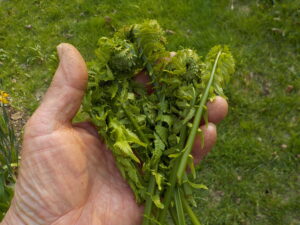
Fiddlehead stems are good tp eat, too.
Fiddleheads are a great spring treat. They are the new shoots of the Ostrich Fern, a big shade-loving fern that is common in New England. All ferns come up as fiddleheads, but only the Ostrich fern is tasty. There is an easy way to identify them: they are the only ones that have a groove up the inside of the stem – just like celery.
I sauté fiddleheads in butter in a cast iron frying pan. First I brown some slivered almonds in olive oil, then add the fiddleheads and some chopped garlic or the bulbs of ramps (more on them below). I pick not only the curled part of the fiddlehead, but also the first 6 inches of stem. But I only take one or two fiddleheads from each plant to allow it to develop well.
Ramps, also called wild leeks, are easy to grow if you have an open wooded area with maple, ash or beech. They are commonly sold now at farmers markets. Both the bulb and the leaves are edible, so cut off the bulbs and plant them. Next year they will please you by showing up in early spring. If you plant 25 to 50 bulbs each year for 3 years or more, you will develop a nice patch. Once established they will spread by seed and root.
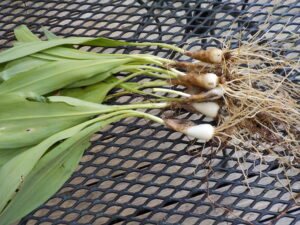
Ramps are easy to grow and a real spring treat
My favorite way of eating ramps is to clean them and rub off the gelatinous covering of the bulb, and then chop the entire plant for cooking. I fry them in a cast iron pan until the leaves wilt, then make scrambled eggs. They can also be added to anything that require garlic or onion – they are the same family.
We will have to wait until July or August to get our tomatoes, even those like ‘Early Girl’ and ‘Fourth of July’ that are quick oto produce. But if you start some perennials in your garden, you can be enjoying taste treats even now, in May. I am.
Henry Homeyer is the author of 4 gardening books. His email is
henry.homeyer@comcast.net. he is a liflelong organic gardener and a 20+-year veteran of the UNH master Gardener program.
Early Edibles from the Garden and Woods
Posted on Tuesday, April 14, 2020 · Leave a Comment
Okay, you may not want to go to the grocery store so much anymore. Tired of eating canned beans? Want something new for your taste buds? Here are some early things I look forward to each spring. These plants are all perennials, so if you don’t have them, you will need to plant them this year for future years.
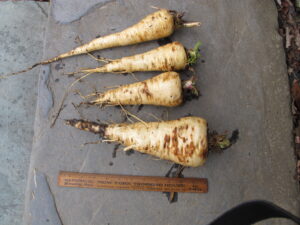
Parsnips
Parsnips that I planted the previous spring are always one of my first garden treats. I harvest them as soon as the soil thaws. Yes, it’s an old fashioned vegetable, but it’s tasty if prepared properly and easy enough to grow.
Plant parsnip seeds in early summer for next spring’s fare. But if you have seeds saved from last year, don’t use them. Although most vegetable and flower seeds are good for 3 years, parsnip seeds are only good for one year – as are onion and parsley seeds.
Parsnips take an interminable time to germinate – 3 weeks, on average. The roots survive winters in the ground, but the seeds like warm soil to germinate. And as with most root crops, no one starts them indoors to get them going early. Just plant them in the ground in late May or early June. Thin to 2 or 3 inches between plants by the Fourth of July.
As to eating parsnips, don’t overcook them. Steam lightly or sauté them in butter and coat with maple syrup at the last minute. The syrup will glaze them and make the dish fit for a queen. You can cook them with carrots or add fennel seeds for a change of pace.
Next I go to my woods for a real treat: ramps. These are also called wild leeks, and are related to onions, leeks and garlic. They grow wild in moist, dark soil, often alongside streams in maple and beech forests. They often grow in huge swaths, thousands growing in one area. But they are slow growing, so don’t over-harvest them.
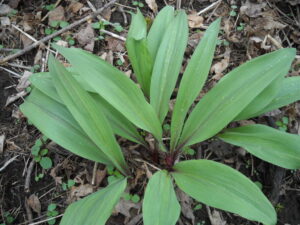
Ramps growing in my woods
For several years I dug up and planted about 50 ramps plants each year in my woods, and they have multiplied by offsets nicely. Two or three years ago I started harvesting seeds in late summer and sprinkling them on the soil and covering with just a little forest duff. These have grown and are doing nicely, though they are still too small to eat.
If you want to start some ramps in your woods, find a friend who will teach you how to recognize them. Ramps have pointed green leaves roughly the shape of a canoe and 6 to 9 inches long. They grow from a single point, each plant having 2 to 4 leaves. Frequently the base of the stem is maroon, but it may be green. And the key is this: they smell like garlic. You need to dig down 4 inches or so in the soil to harvest the bulbs, which slightly resemble leeks.
I use ramps the way I use onions – I add them to stir fries, scrambled eggs and stews. The nice thing is, you can eat the leaves, not just the little bulbs.
Another early spring treat is a perennial green called sorrel. Although seeds are available, I recommend buying plants at your local garden center if possible because it takes a long time to get big plants from seed. This plant’s leaves are very tart and almost lemon flavored.
When cooked, sorrel leaves cook down to almost nothing. Fortunately, I found a recipe in Deborah Madison’s fabulous cookbook, Vegetable Literacy, which takes advantage of sorrel’s sharp flavor, but mixes it in with other veggies to bulk it up. Here is what you can do:
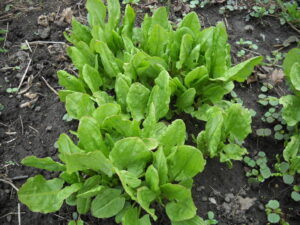
Sorrel in early spring
Melt 1 tablespoon of butter in a pan, add 5 ounces of leeks (I always have some frozen from my garden) and 1 cup of water, and simmer 10 minutes covered on medium heat. Add 1.5 cups of peas and 3 cups water and simmer for 5 minutes. The stir in 2 to 3 cups sorrel, allow to wilt, and puree in a blender. Finally stir in a little cream, crème fraiche or yogurt.
The last of my early spring treats is another old fashioned one: rhubarb. Like sorrel, this has a tangy, sharp flavor. I love it in pies, tapioca pudding and jam. Some cooks spoil it by cooking with strawberries, but I feel that diminishes its flavor.
Rhubarb is easy to grow. You will need to buy plants or get roots from a friend – although rhubarb produces flowers stalks and seeds by the gazillion, it does not easily reproduce that way, though I’m told it can be done.
Amend the soil with lots of compost and/or aged manure. Add some organic fertilizer, too, as the roots will be in the same soil for decades – rhubarb lasts forever. I have some plants over 25 years old and going strong. Full sun is best, but like any leafy green it will produce in part shade. Four hours of sunshine will be fine.
One of my favorite rhubarb uses is to make punch. Chop up a few stems and boil in an equal quantity of water. Once it gets mushy you can strain it and add more water and some sugar until you have a nice drink. I just use a little sugar – I like the tea plenty tart. I like to use red stems for the tea, as it looks so nice in a glass or cup. Most people who grow rhubarb have plenty, so you might beg a few stalks if you don’t have your own – yet.
A Taste of Spring!
Posted on Monday, April 24, 2017 · Leave a Comment
I’m already eating a few of my own fresh vegetables: ramps, dandelion greens and sorrel are ready, and soon will come those perennial delicacies, asparagus and rhubarb.
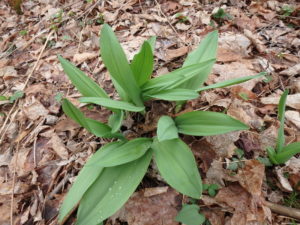
Ramps are up and ready to harvest
It took me nearly 10 years, but I now have a patch of ramps that produces enough of these wild members of the onion family that I don’t have to go hiking to dig up the ramps I need. I sauté both the bulb and the leaves, and find them a great spring treat in eggs or a stir fry.
Ramps are often found in areas with moist soil and filtered sun and shade. They are slow-growing, but I have added 50 or so plants most years for 10 years and the older clumps are ready for harvesting.
Ramps often are found in patches of a million or more, but that does not mean you can be careless about harvesting them – a patch that sizes takes a lifetime or more to develop. Dig a few in one spot, move to another – and never take all from any one location. If I dig out 25 from one spot, I am sure to leave half a dozen in the ground.
If you want to start your own patch, first learn to identify the plant. They have leaves that are 6 to 12 inches long and 1 to 3 inches wide with a pointy end. There is a groove down the middle of the leaf, and the lower stem may have some maroon coloring. And the scent is distinct, similar to garlic and leeks. The bulbs are half an inch wide or so, and two inches long or less, depending when you pull them. There is an outer sheath over the bulb which you should slide off when you cut off the roots.
To grow your own, carefully observe where you find them in the wild. Look at the trees: often maples and beech, sometimes ash or poplar form the canopy. Wildflowers that grow along with ramps include spring beauty, Dutchman’s breeches and trout lily.
The soil for growing ramps should be rich and dark. If you want some near the house and kitchen, dig some up and try to match the environment where you find them in the wild. Be sure to ask the landowner if you want to take some from a neighbor. These are spring ephemerals, so the leaves will die and disappear before mid-summer.
I know that many gardeners think of dandelions as pests, and they can be. But they are also tasty if you dig some before they bloom; after blooming they tend to get bitter.

A kitchen knife is good for slicing dandelions
To harvest dandelions, bring a table knife with you to a patch of lawn or garden that has not been treated with chemicals – no herbicides, no chemical fertilizers, no pesticides. Slice the roots an inch beneath the soil surface and lift the dandelion carefully as you don’t want to sprinkle any soil onto the greens. The white portion just beneath the soil is delicious, but you can toss the brown-skinned tap root.
I wash the dandelions with the sprayer in my kitchen sink, and then leave the roots in a bowl of water to loosen any more soil. Then I return and rinse them after soaking. I like to steam them lightly, then serve with cider vinegar or a little butter. Although I eat them the same day I pick them, my late friend Rev Wightman used to freeze them and eat them throughout the year.
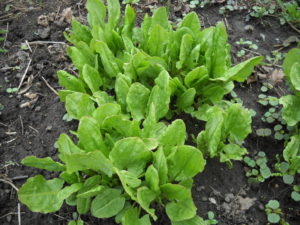
Sorrel is a perennial green with a lemony flavor
Sorrel is a great favorite of French cooks who make a soup with it. Although I grow it, I am not wild about it. It is a bright leafy green that comes back, year after year. It has a sharp lemony flavor, a bit like wood sorrel. My problem with it is that when you cook it, it practically disappears. It has little substance. But it’s easy to grow, and adds a unique flavor if added to a salad or even a sandwich. Plants are often sold at garden centers in the herb section.
My rhubarb is up! I love rhubarb for its sharp flavor, one that I have been told is among the last to disappear for the elderly when they lose their ability to sense flavors.
Rhubarb is easy to grow. It does best in full sun with rich moist soil. I have grown it in dry soil and although it grows in dry places, it is not as vigorous. It has a deep fleshy root. If you have a friend with a rhubarb patch, it is easy to dig some out and bring it home. Just plunge a spade into the middle of a plant, and then around it, and lift out a section of root. Add plenty of compost and organic fertilizer to the soil when you plant it.
Rhubarb comes in green-stemmed and red-stemmed varieties. I like the red, though I doubt there is a difference in taste. The leaves are a little toxic – they contain oxalic acid – but are not going to kill you if you eat some.
For a spring drink, chop a pound of stems, add water, and boil until soft. Drain off the mush, add some sugar and more water for a tasty pink drink that has got to be healthier for you than soda!
Eating seasonally is good for you – and I like having treats now that I only get once a year. Soon fiddleheads will be up – but more on that another day.
Henry’s blog appears twice a week at https://dailyuv.com/gardeningguy His e-mail is henry.homeyer@comcast.net












